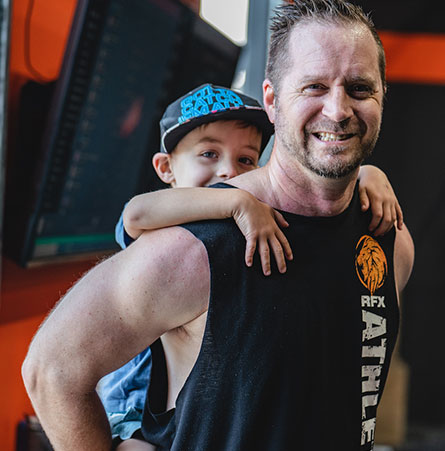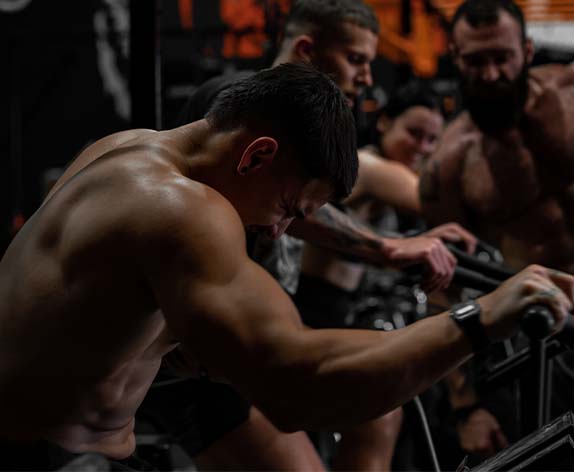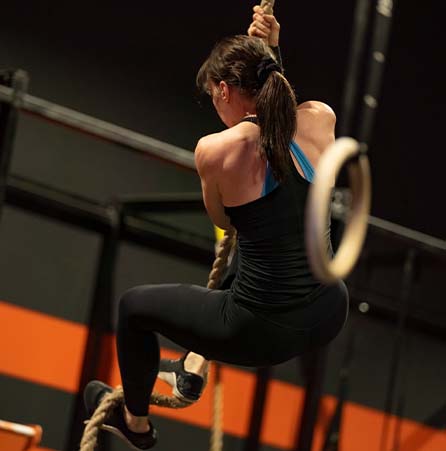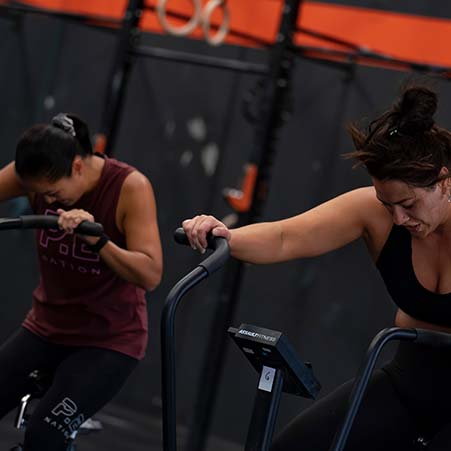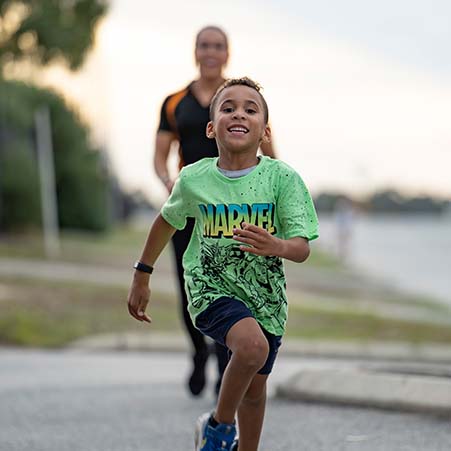Recovery is often an overlooked aspect of fitness, especially in high-intensity workouts like CrossFit. Many athletes focus solely on pushing their limits during training, but without proper recovery, all that hard work can lead to burnout or injury. At RFX’s Recovery Hub, we’re here to highlight the importance of recovery and how it can enhance your CrossFit experience. From tailored recovery plans to community support, we’ll explore how you can optimise your recovery strategies to improve performance and well-being.
Key Takeaways
- Recovery is essential for performance and injury prevention in CrossFit.
- RFX’s Recovery Hub offers various tools and personalised recovery plans.
- Different fitness levels require tailored recovery strategies.
- Effective recovery can help prevent common CrossFit injuries.
- Nutrition and mental health play a significant role in the recovery process.
Understanding The Role Of Recovery In CrossFit
The Science Behind Recovery
Recovery isn’t just about rest; it’s a complex biological process. When you smash out a WOD, you’re essentially creating micro-tears in your muscle fibres. CrossFit recovery is all about repairing these tears, replenishing energy stores (glycogen), and reducing inflammation. This involves a cascade of hormonal and cellular responses. Understanding this science helps you appreciate why recovery strategies are so important.
Benefits Of Adequate Recovery
What happens if you actually prioritise recovery? Well, a lot of good things, actually. Here’s a few:
- Improved Performance: Muscles rebuild stronger, allowing you to push harder in your next workout.
- Reduced Risk of Injury: Overtraining leads to fatigue and poor form, increasing the likelihood of strains and sprains. Adequate recovery helps prevent this.
- Better Sleep: Recovery practises, like stretching and mindfulness, can improve sleep quality, which is crucial for overall health and performance.
Ignoring recovery is like trying to drive a car without putting fuel in it. You might get somewhere for a little while, but eventually, you’ll grind to a halt. Prioritising recovery ensures you can keep pushing your limits without burning out.
Common Misconceptions About Recovery
There are a few myths floating around about CrossFit recovery. One is that it’s only for elite athletes. Nope! Everyone needs recovery, regardless of their fitness level. Another misconception is that recovery means doing nothing. Active recovery, like light cardio or stretching, can actually be more beneficial than complete rest. The biggest misconception? That recovery is optional. It’s not. It’s as important as the workout itself.
Exploring RFX’s Recovery Hub Services
Okay, so you’re pushing hard in your CrossFit workouts, right? But are you giving your body the TLC it needs after? That’s where RFX’s Recovery Hub comes in. It’s not just about smashing PBs; it’s about smart training, and a huge part of that is recovery. Let’s have a look at what RFX offers to help you bounce back stronger.
Overview Of Recovery Tools
RFX’s Recovery Hub is kitted out with all sorts of gear to help your body repair and rebuild. Think of it as your post-workout pit stop. What kind of tools are we talking about? Well:
- Foam rollers: These are great for self-myofascial release, which basically means you’re giving yourself a massage to loosen up tight muscles.
- Massage guns: These provide a deeper, more targeted massage than foam rollers, helping to break up knots and improve blood flow.
- Compression boots: These use air pressure to massage your legs, reducing swelling and soreness. They’re like a hug for your tired muscles.
- Sauna/Steam Room: Heat therapy can help relax muscles, reduce pain, and improve circulation. It’s also a great way to sweat out toxins.
Using these tools isn’t just about feeling good (although that’s a bonus!). It’s about actively working to reduce muscle damage, decrease inflammation, and get you ready for your next session. It’s an investment in your long-term fitness.
Personalised Recovery Plans
Everyone’s different, right? What works for your mate might not work for you. That’s why RFX offers personalised recovery plans. These plans are tailored to your specific needs, taking into account your training intensity, workout frequency, and any niggles or injuries you might have. How do they do it?
- Assessment: A coach will assess your current recovery habits and identify any areas for improvement.
- Goal Setting: You’ll work together to set realistic recovery goals.
- Plan Development: A personalised plan will be created, incorporating the recovery tools and techniques that are most effective for you.
These plans aren’t set in stone. They’re constantly reviewed and adjusted based on your progress and feedback. It’s all about finding what works best for you.
Community Support And Resources
Recovery isn’t just a solo mission; it’s easier when you’ve got a team around you. RFX fosters a supportive community where you can share tips, ask questions, and motivate each other. Plus, they provide a bunch of resources to help you stay on track. What kind of support are we talking about?
- Workshops: Regular workshops on recovery techniques, nutrition, and injury prevention.
- Coaching: Access to experienced coaches who can provide guidance and support.
- Online Forum: A place to connect with other members, share your experiences, and ask for advice.
Having access to this kind of support can make a huge difference in your recovery journey. It’s about learning from others, staying motivated, and knowing that you’re not alone. Remember, RFX Athletic Bibra Lake is more than just a gym; it’s a community that cares about your well-being.
Tailoring Recovery Strategies For Different Fitness Levels
It’s easy to think that recovery is a one-size-fits-all thing, but that’s just not true. What works for a seasoned CrossFit athlete isn’t going to cut it for someone just starting out. Your fitness level plays a huge role in the type and amount of recovery you need. Let’s break down how to tailor your recovery based on where you’re at.
Beginner Recovery Techniques
So, you’re new to CrossFit? Welcome! Don’t jump straight into the most intense workout recovery routines. Your body needs time to adapt. Here’s what to focus on:
- Prioritise Sleep: Aim for 7-9 hours of quality sleep each night. This is when your body does most of its repair work.
- Gentle Movement: Light activities like walking, swimming, or yoga can help reduce muscle soreness and improve blood flow.
- Basic Nutrition: Focus on whole, unprocessed foods. Make sure you’re getting enough protein to help your muscles rebuild.
Listen to your body. If something feels painful, stop. Don’t push yourself too hard, especially when you’re just starting out. Recovery is just as important as the workouts themselves.
Intermediate Recovery Approaches
Okay, you’ve been doing CrossFit for a while now. You’re getting stronger, faster, and more skilled. Your recovery needs to evolve too. Time to add some more advanced techniques:
- Foam Rolling: Incorporate foam rolling into your routine to target specific muscle groups and release tension.
- Active Recovery: Include more structured active recovery sessions, like light CrossFit workouts at a lower intensity.
- Hydration and Electrolytes: Pay closer attention to your hydration, especially after intense workouts. Consider adding electrolytes to replenish what you’ve lost through sweat.
Advanced Recovery Protocols
You’re a CrossFit pro. You’re pushing your body to its limits. Your recovery needs to be on point to avoid burnout and injury. This is where things get serious:
- Cold Water Immersion: Ice baths or cold showers can help reduce inflammation and speed up recovery.
- Compression Gear: Using compression clothing can improve blood flow and reduce muscle soreness.
- Personalised Nutrition: Work with a nutritionist to develop a tailored meal plan that supports your training and recovery needs.
Advanced athletes should consider tracking metrics like heart rate variability (HRV) to monitor their recovery status. This can help you identify when you’re overtraining and need to scale back.
No matter your fitness level, remember that recovery is an ongoing process. It’s not something you do just when you’re feeling sore or tired. It’s an integral part of your training. If you’re unsure where to start, consider visiting a fitness recovery hub for personalised guidance.
Injury Prevention Through Effective Recovery
CrossFit is awesome, but it can be tough on the body. Ignoring recovery is like skipping maintenance on your car – eventually, something’s gonna break. Let’s look at how proper recovery can keep you in the game and out of the physio’s office.
Identifying Common CrossFit Injuries
CrossFit pushes you hard, and that’s part of the appeal. But all that intensity can lead to some common injuries. We’re talking about things like:
- Shoulder issues: Rotator cuff problems are pretty common due to all the overhead work.
- Lower back pain: All those deadlifts and squats can put a strain on your back if you’re not careful.
- Knee problems: Knee pain management can arise from squatting, jumping, and running.
- Wrist injuries: Think about all the weight-bearing on your wrists during movements like handstands and push-ups.
- Achilles tendonitis: All the jumping and plyometrics can irritate the Achilles tendon.
These injuries often happen because of overuse, poor form, or not enough recovery. Knowing what to look out for is the first step in preventing them.
How Recovery Aids Injury Prevention
Recovery isn’t just about feeling good; it’s about preventing injuries. When you work out, you’re actually creating tiny tears in your muscles. Recovery gives your body the time and resources it needs to repair those tears and rebuild stronger. Without adequate recovery, those micro-tears can accumulate, leading to inflammation, pain, and eventually, injury.
Here’s how recovery helps:
- Reduces inflammation: Recovery techniques like ice baths and using infrared, compression, and massage for recovery help reduce inflammation, which is a major contributor to pain and injury.
- Improves muscle flexibility and range of motion: Stretching and mobility work can help improve flexibility and range of motion, reducing the risk of strains and sprains.
- Enhances blood flow: Recovery strategies like active recovery and massage can improve blood flow to your muscles, delivering nutrients and removing waste products.
- Reduces muscle soreness: Delayed onset muscle soreness (DOMS) can make it harder to perform at your best and increase your risk of injury. Recovery helps reduce DOMS, so you can get back to training sooner.
Long-Term Benefits Of Recovery
Thinking about recovery as a long-term investment is a good idea. It’s not just about avoiding injuries today; it’s about staying healthy and active for years to come. Here are some of the long-term benefits of prioritising recovery:
- Increased longevity in CrossFit: By preventing injuries and burnout, you’ll be able to continue doing CrossFit for longer.
- Improved overall health and well-being: Recovery isn’t just about your muscles; it’s about your whole body. Proper recovery can improve your sleep, reduce stress, and boost your immune system.
- Better performance: When you’re well-rested and recovered, you’ll be able to train harder and see better results.
- Reduced risk of chronic pain: Ignoring recovery can lead to chronic pain conditions like tendinitis and bursitis. Prioritising recovery can help prevent these problems.
Recovery is an ongoing process, not a one-time fix. Make it a regular part of your CrossFit routine, and your body will thank you for it. Listen to your body, adjust your training as needed, and don’t be afraid to take rest days. Your long-term health and performance depend on it.
Integrating Recovery Into Your CrossFit Routine
It’s easy to get caught up in the intensity of CrossFit and want to push yourself every single day. But trust me, learning how to recover after intense CrossFit is just as important as the workouts themselves. Think of it as part of the training, not something extra you might do if you have time. It’s about finding a sustainable rhythm that keeps you progressing without burning out or getting injured.
Scheduling Recovery Days
Okay, so how do you actually fit recovery into your week? It’s not just about collapsing on the couch (though that’s part of it!). It’s about planning rest days just like you plan your WODs.
Here’s a few things to consider:
- Listen to your body: If you’re feeling constantly sore or fatigued, that’s a sign you need more rest.
- Active recovery: Instead of doing nothing, try light activities like walking, swimming, or yoga on your recovery days. This helps with blood flow and reduces muscle stiffness.
- Plan ahead: Look at your workout schedule for the week and intentionally schedule rest days. Don’t just wait until you’re completely exhausted.
Balancing Workouts And Recovery
Finding the right balance between pushing yourself and resting is key. It’s a bit of an art, and it takes time to figure out what works best for you.
Here’s a few tips:
- Vary your intensity: Not every workout needs to be a max effort. Mix in some lighter days to give your body a break.
- Prioritise sleep: Aim for 7-9 hours of quality sleep each night. This is when your body does most of its repair work.
- Don’t skip warm-ups and cool-downs: These are important for preparing your body for exercise and helping it recover afterwards.
Listening To Your Body
This is probably the most important thing. You know your body better than anyone else. Pay attention to the signals it’s sending you.
If you’re feeling pain, don’t push through it. Rest, ice, and see a physio if needed. Ignoring pain can lead to more serious injuries down the road. It’s better to take a few days off now than to be sidelined for weeks or months later.
Here’s what to look out for:
- Persistent soreness: If your muscles are still sore days after a workout, you might be overdoing it.
- Fatigue: Feeling constantly tired, even after getting enough sleep.
- Decreased performance: If you’re not able to lift as much weight or do as many reps as usual, it could be a sign of overtraining.
Recovery is not a luxury; it’s a necessity for long-term progress and injury prevention in CrossFit.
The Importance Of Nutrition In Recovery
Nutrition plays a massive role in how well you recover after a tough CrossFit session. It’s not just about getting enough calories; it’s about fuelling your body with the right nutrients at the right time. Neglecting your nutrition can undo all the hard work you put in at the box. So, what should you be eating, and when?
Nutritional Guidelines For Recovery
Focus on a balanced intake of macronutrients: protein, carbohydrates, and fats. Protein is crucial for muscle repair, carbs replenish glycogen stores, and fats support hormone production and overall energy balance. Don’t skimp on any of them!
Here’s a simple breakdown:
- Protein: Aim for 0.8-1 gramme per pound of body weight, especially after workouts.
- Carbohydrates: Choose complex carbs like sweet potatoes, brown rice, and oats.
- Fats: Opt for healthy fats from sources like avocados, nuts, and olive oil.
It’s easy to fall into the trap of thinking more is better, but that’s not always the case. Focus on quality over quantity. A well-rounded diet will always beat a pile of supplements.
Hydration Strategies
Dehydration can seriously hinder your recovery. Water helps transport nutrients, regulate body temperature, and flush out waste products. You should be drinking water throughout the day, not just after your workout.
Here are some tips:
- Drink water before, during, and after your workout.
- Consider electrolyte drinks, especially after intense sessions, to replace lost minerals.
- Monitor your urine colour – it should be pale yellow.
Supplements That Support Recovery
While a balanced diet should be your priority, some supplements can provide extra support. However, it’s important to do your research and consult with a healthcare professional before adding anything new to your routine. There are many best post-workout recovery tools available, but not all are created equal.
Here are a few commonly used supplements:
- Creatine: Can improve strength and power output.
- Whey Protein: A convenient way to boost protein intake.
- Omega-3 Fatty Acids: May help reduce inflammation.
Mental Recovery: The Overlooked Aspect

We often focus on the physical demands of CrossFit, but what about the mental side? It’s easy to push your body to its limits, but neglecting your mental wellbeing can hinder your progress and increase your risk of burnout. Mental recovery is just as important as physical recovery, and it’s time we gave it the attention it deserves.
The Connection Between Mind And Body
The mind and body are intricately linked. Stress, anxiety, and fatigue can manifest physically, impacting your performance and recovery. When you’re mentally drained, your body feels it too. Ignoring mental fatigue can lead to decreased motivation, poor decision-making during workouts, and even increased susceptibility to injuries. It’s a two-way street: physical exertion affects your mental state, and vice versa. Think of it like this: if you’re constantly stressed about work, you’re less likely to have the energy or focus to smash your WOD.
Techniques For Mental Recovery
So, how do you actively recover mentally? It’s not just about zoning out in front of the TV (though that can help sometimes!). Here are a few techniques to try:
- Mindfulness and Meditation: Even a few minutes of daily meditation can significantly reduce stress and improve focus. There are plenty of apps and online resources to guide you.
- Journaling: Writing down your thoughts and feelings can help you process emotions and gain clarity. It’s a great way to identify stressors and develop coping strategies.
- Spending Time in Nature: Getting outdoors has a calming effect on the mind and body. A walk in the park or a hike in the bush can do wonders for your mental wellbeing.
- Disconnecting from Technology: Constant exposure to screens and social media can be overwhelming. Set aside time each day to disconnect and engage in activities that you enjoy.
- Practising Gratitude: Focusing on the positive aspects of your life can boost your mood and reduce feelings of stress and anxiety. Keep a gratitude journal or simply take a few moments each day to appreciate the good things in your life.
Building Resilience Through Recovery
Mental recovery isn’t just about managing stress; it’s about building resilience. Resilience is your ability to bounce back from challenges and setbacks. By prioritising mental recovery, you’re equipping yourself with the tools to cope with stress, overcome obstacles, and maintain a positive mindset. This, in turn, will improve your overall performance and enjoyment of CrossFit. Think of it as mental strength training – the more you practise, the stronger you become. And remember, seeking support from friends, family, or a mental health professional is a sign of strength, not weakness. Don’t hesitate to reach out if you’re struggling. You can also look into dietary changes to help with your mental recovery.
Mental recovery is often ignored, but it’s just as important as physical recovery. Taking time to relax and clear your mind can help you feel better and perform better in your daily life. Don’t underestimate the power of mental rest! If you want to learn more about how to improve your mental recovery, visit our website today!
Wrapping Up: The Role of Recovery in Fitness
In summary, recovery is a big deal when it comes to staying fit and avoiding injuries. RFX’s Recovery Hub has got a range of tools and services that can help anyone, no matter their fitness level. Whether you’re just starting out or you’ve been at it for years, having a solid recovery plan is key. So, if you want to keep pushing your limits and feeling your best, consider making recovery a priority. It’s not just about working hard; it’s about taking care of your body too.
Frequently Asked Questions
Why is recovery important in CrossFit?
Recovery helps your body heal and get stronger after workouts. It can prevent injuries and improve your performance.
What services does RFX’s Recovery Hub offer?
RFX offers tools like massage therapy, ice baths, and personal recovery plans to help you recover better.
How can I create a recovery plan?
A recovery plan should fit your fitness level. Beginners might need simple stretches, while advanced athletes may need more complex strategies.
What should I do if I get injured?
If you get hurt, it’s important to rest and use recovery methods like ice or compression. Always consult a professional if you’re unsure.
How can I tell if I need a recovery day?
Listen to your body. If you’re feeling tired or sore, it might be time for a recovery day to help you recharge.
Does nutrition affect recovery?
Yes! Eating well and staying hydrated are key to helping your body recover faster after workouts.

